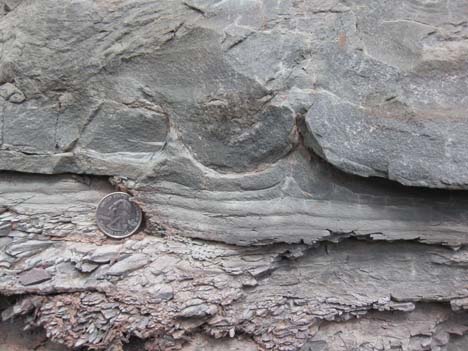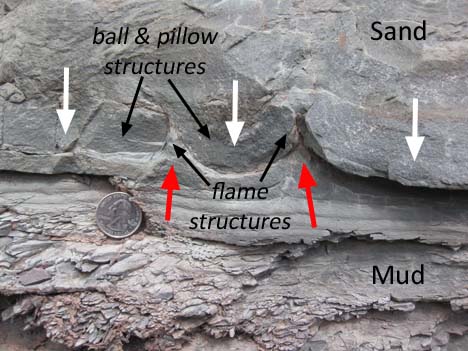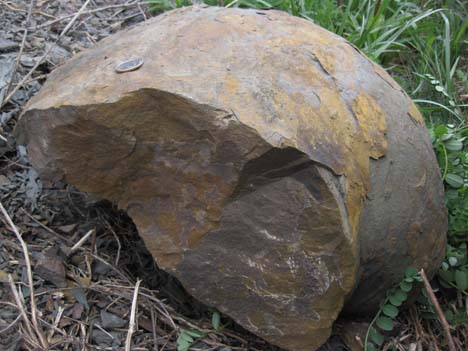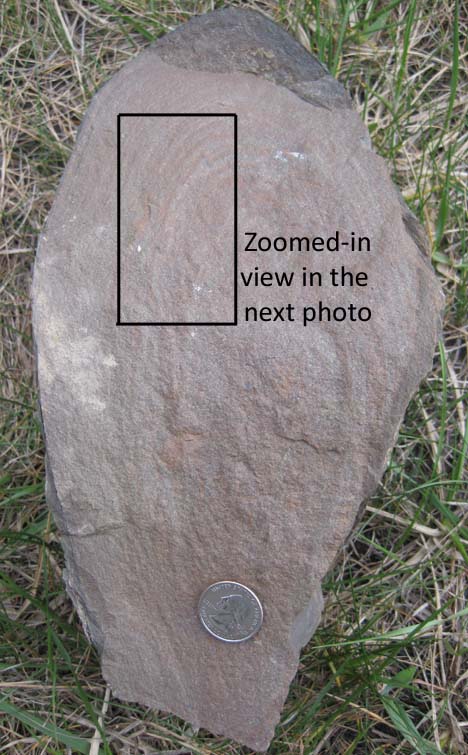I took a look at some interesting blobby structures in the Swift Run Formation last week, and walked readers through my logic in tentatively concluding that they were ball & pillow structures (soft sediment deformation), though overprinted by a pervasive (Alleghanian) cleavage. As we move west in the Appalachian mountain belt, the rocks are less cleaved: the strain is instead taken up in large anticlines and synclines with a few thrust faults thrown in. Though arched and fractured, the rocks’ fabrics remain pretty close to what they were at the time of deposition.
Fortunately, in the Valley & Ridge province along New Route 55 in West Virginia, you can see some sweet examples of (undeformed) ball & pillow in the Hampshire Formation (Devonian; part of the Acadian clastic wedge). Here’s a view looking up at the bottoms of some of these sandy sags (quarter for scale):
I like that partial weathering-out of the features into the third dimension…
To refresh your memory, ball & pillow forms when a heavy load of sand gets dumped (underwater) on top of a soft, squishy deposit of mud. The sand sags downward in broad “balls” (if you have a point locus of sinking) or “pillows” (if the sags have a linear axis to them). In between, the low-viscosity mud squirts up in cuspate “flame” structures. Check out this fine example (quarter for scale), found by GMU structure students Joe M. and Justin O. on the northern side of the road:
…And here we have the same photo, with the sand, mud, flames, and ball & pillow all labeled for you. The white arrows represent the downward sagging of the sand; the red arrows represent the upward squirting of the mud.
In some places, the pillows have weathered out. Here’s one (quarter for scale) that is now upside down on the grassy knoll beneath its source outcrop:
Note the thin laminae of mud clinging to its exterior, like a coat of paint!
Here’s a second sandstone pillow that has weathered out of the cliff and popped down onto the grassy slopes below. Obviously, the surface being photographed is a cross-section through the saggy pillow:
The “upper left” of this sample would have been the lowpoint of the sag if it were in situ on the outcrop. You can see the smooth margin on the left side, and the rougher zone on the right where it detached from the overlying part of the sandy layer. Let’s now zoom in on this box to see something really cool:
If we go deep here, we can see that the laminations of sand within the pillow show small Z-folds (and S-folds on the other side, though they’re not as obvious in the photograph) that are “parasitic” on the main fold. Here they are, highlighted (white arrows) and traced out (black lines):
The axes of these small-scale structures verge on the axis of the main fold, meaning that their axial planes (blue traces) “tip over” with increasing deformation towards parallelism with the main fold’s axial plane. We’ve seen similar things before. The axial planes play the same game as the cleavage plane. This is the first time I have ever observed such a structure associated with soft-sediment deformation, however.
Has anyone else ever seen S- or Z-folds associated with soft sediment deformation? It makes total sense to me that they would be there based on simple physics, but this was the first time I had ever seen it myself. I’d be curious to get a sense of how common or rare this might be.







